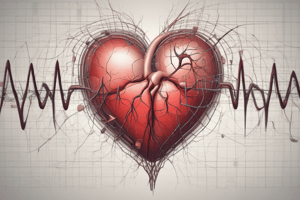Podcast
Questions and Answers
Why is defibrillation not indicated for Pulseless Electrical Activity (PEA) or Asystole?
Why is defibrillation not indicated for Pulseless Electrical Activity (PEA) or Asystole?
- There is no electrical activity to synchronize, rendering defibrillation ineffective. (correct)
- The primary issue in PEA and Asystole is a rhythm disturbance that defibrillation cannot correct.
- The heart muscle is already contracting forcefully; defibrillation would cause further damage.
- Defibrillation can worsen the underlying cause of PEA and Asystole.
A patient in PEA is found to be hypovolemic. Besides epinephrine, what is the MOST appropriate intervention?
A patient in PEA is found to be hypovolemic. Besides epinephrine, what is the MOST appropriate intervention?
- Prepare for transcutaneous pacing.
- Administer a bolus of intravenous fluids. (correct)
- Administer a vasopressor such as vasopressin.
- Perform immediate pericardiocentesis.
During resuscitation of a patient in PEA, how frequently should epinephrine 1mg be administered?
During resuscitation of a patient in PEA, how frequently should epinephrine 1mg be administered?
- Every 2 minutes
- As a one-time dose only
- Every 3-5 minutes or every other pulse check (correct)
- Every 10-15 minutes
A patient is in PEA and IV access cannot be established. What is the next preferred route of medication administration?
A patient is in PEA and IV access cannot be established. What is the next preferred route of medication administration?
Why might CPR potentially induce ventricular tachycardia (VT) or ventricular fibrillation (VF) in a patient?
Why might CPR potentially induce ventricular tachycardia (VT) or ventricular fibrillation (VF) in a patient?
During resuscitation of a patient in PEA (Pulseless Electrical Activity), what key actions should be performed every two minutes?
During resuscitation of a patient in PEA (Pulseless Electrical Activity), what key actions should be performed every two minutes?
After 20 minutes of CPR, what ETCO2 value suggests that efforts should be stopped?
After 20 minutes of CPR, what ETCO2 value suggests that efforts should be stopped?
In a patient experiencing cardiac arrest due to accidental hypothermia, what is the MOST appropriate intervention during rewarming?
In a patient experiencing cardiac arrest due to accidental hypothermia, what is the MOST appropriate intervention during rewarming?
Which characteristic is unique to Mobitz Type I (Wenckebach) second-degree AV block?
Which characteristic is unique to Mobitz Type I (Wenckebach) second-degree AV block?
Mobitz Type II second-degree AV block is MOST accurately characterized by which of the following?
Mobitz Type II second-degree AV block is MOST accurately characterized by which of the following?
Why is a third-degree AV block considered the most clinically significant type of AV block?
Why is a third-degree AV block considered the most clinically significant type of AV block?
A patient with a third-degree AV block has narrow QRS complexes on their ECG. This indicates:
A patient with a third-degree AV block has narrow QRS complexes on their ECG. This indicates:
When managing a patient with a third-degree AV block, why is pacing preferred over atropine?
When managing a patient with a third-degree AV block, why is pacing preferred over atropine?
Flashcards
What is PEA?
What is PEA?
Pulseless Electrical Activity; there's electrical activity but no pulse.
PEA or Asystole: First Action?
PEA or Asystole: First Action?
Start CPR immediately to circulate blood and deliver oxygen.
PEA & Asystole: Primary Drug?
PEA & Asystole: Primary Drug?
Epinephrine 1mg every 3-5 minutes, or every other pulse check.
What Defines PEA?
What Defines PEA?
Signup and view all the flashcards
Possible PEA causes?
Possible PEA causes?
Signup and view all the flashcards
ETT (Every Two Minutes)
ETT (Every Two Minutes)
Signup and view all the flashcards
Asystole
Asystole
Signup and view all the flashcards
Asystole Drug
Asystole Drug
Signup and view all the flashcards
Accidental Hypothermia Treatment
Accidental Hypothermia Treatment
Signup and view all the flashcards
Second Degree AV Block Mobitz Type 1 (Wenckebach)
Second Degree AV Block Mobitz Type 1 (Wenckebach)
Signup and view all the flashcards
Second Degree AV Block Mobitz Type 2
Second Degree AV Block Mobitz Type 2
Signup and view all the flashcards
Third-Degree AV Block
Third-Degree AV Block
Signup and view all the flashcards
Third-Degree AV Block HR
Third-Degree AV Block HR
Signup and view all the flashcards



